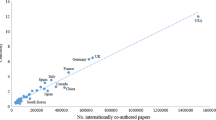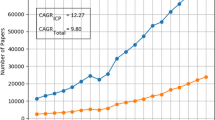Abstract
We examine the structure and dynamics of network of scientific international collaborations within North Africa (Morocco, Algeria, Tunisia and Egypt) using both publishing and patent data. Results show that the region has undergone a sustained process of internationalization, which has translated in both an expansion of the network of scientific collaborations and a relative increase in the research output of international teams. At the same time we find the existence of a very limited degree of scientific integration at the regional level, i.e. within Northern Africa. Among the countries examined, Egypt seems to be the most active one in terms of size of research output as well as number and variety of international collaborations. Moreover, Egypt is the most central node of the regional research network and this centrality has considerably grown over time. This increased importance of Egypt as regional research hub is associated with a remarkable increase in the centrality of Saudi Arabia within Egypt’s research network. This holds across a variety of research fields as well as in terms of applied science (as shown by patent data). Overall, these results suggest that the region is undergoing a deep transformation in the structure and composition of scientific collaborations.











Similar content being viewed by others
Notes
Information on team composition is retrieved from the publication matrix described above. In particular, for each year, we count the number of articles satisfying conditions (1), (2) and (3) and then divide each figure by the total number of articles published that year.
References
Adams, J. (2012). Collaborations: The rise of research networks. Nature, 490(7420), 335–336.
Adams, J., Gurney, K., Hook, D., & Leydesdorff, L. (2014). International collaboration clusters in Africa. Scientometrics, 98(1), 547–556.
Barabâsi, A. L., Jeong, H., Néda, Z., Ravasz, E., Schubert, A., & Vicsek, T. (2002). Evolution of the social network of scientific collaborations. Physica A, 311(3), 590–614.
Beaver, D. D. (2001). Reflections on scientific collaboration, (and its study): Past, present, and future. Scientometrics, 52(3), 365–377.
Bond, M., Maram, H., Soliman, A., & Khattab, R. (2012). Science and innovation in Egypt. London: The Royal Society.
Borgatti, S. P., & Everett, M. G. (2000). Models of core/periphery structures. Social Networks, 21(4), 375–395.
Boshoff, N. (2010). South-South research collaboration of countries in the Southern African Development Community (SADC). Scientometrics, 84(2), 481–503.
Chase-Dunn, C. K. (1998). Global formation: Structures of the world-economy. Lanham: Rowman and Littlefield.
Coffano, M. & Tarasconi, G. (2014). CRIOS—Patstat database: Sources, contents and access rules. CRIOS Working Paper No. 1.
Crane, D. (1972). Invisible colleges: Diffusion of knowledge in scientific communities. Chicago: University of Chicago Press.
Cronin, B., Shaw, D., & La Barre, K. (2004). Visible, less visible, and invisible work: Patterns of collaboration in 20th century chemistry. Journal of the American Society for Information Science and Technology, 55(2), 160–168.
de Noovy, W., Mrvar, A., & Batagelj, V. (2005). Exploratory social network analysis with Pajek. Cambridge, UK: Cambridge University Press.
Frenken, K., Hardeman, S., & Hoekman, J. (2009). Spatial scientometrics: Towards a cumulative research program. Journal of Informetrics, 3(3), 222–232.
Glänzel, W., & Schubert, A. (2005). Analysing scientific networks through co-authorship: Handbook of quantitative science and technology research (pp. 257–276). Berlin: Springer.
Global Research Report. (2011). Middle East: Exploring the changing landscape of Arabian, Persian and Turkish research. London: Evidence-Thomson Reuters.
Grossman, J. W. (2002). The evolution of the mathematical research collaboration graph. Congressus Numerantium, 158, 201–212.
Katz, J. S. (1994). Geographical proximity and scientific collaboration. Scientometrics, 31(1), 31–43.
Krugman, P. (1996). The self-organizing economy (Vol. 122). Cambridge, MA: Blackwell Publishers.
Kuhn, T. S. (1962). The structure of scientific revolutions. Chicago and London: University of Chicago Press.
Latour, B. (1987). Science in action: How to follow scientists and engineers through society. Cambridge, MA: Harvard University Press.
Mêgnigbêto, E. (2013). International collaboration in scientific publishing: The case of West Africa (2001–2010). Scientometrics, 96(3), 761–783.
Moody, J. (2004). The structure of a social science collaboration network: Disciplinary cohesion from 1963 to 1999. American Sociological Review, 69(2), 213–238.
Onyancha, O. B., & Maluleka, J. R. (2011). Knowledge production through collaborative research in sub-Saharan Africa: How much do countries contribute to each other’s knowledge output and citation impact? Scientometrics, 87(2), 315–336.
Persson, O., Glanzel, W., & Danell, R. (2004). Inflationary bibliometric values: The role of scientific collaboration and the need for relative indicators in evaluative studies. Scientometrics, 60, 421–432.
Shin, J. C., Lee, S. J., & Kim, Y. (2013). Research collaboration across higher education systems: Maturity, language use, and regional differences. Studies in Higher Education, 38(3), 425–440.
Sonnenwald, D. H. (2007). Scientific collaboration. Annual Review of Information Science and Technology, 41, 643–681.
Steiber, S. R. (1979). The world system and world trade: An empirical exploration of conceptual conflicts. The Sociological Quarterly, 20(1), 23–36.
Wagner, C. S., & Leydesdorff, L. (2005). Network structure, self-organization, and the growth of international collaboration in science. Research Policy, 34(10), 1608–1618.
Wallerstein, I. (2011). The modern world-system (Vol. 1). Oakland: University of California Press.
Wasserman, S., & Faust, K. (1994). Social network analysis: Methods and applications (Vol. 8). Cambridge: Cambridge University Press.
Author information
Authors and Affiliations
Corresponding author
Appendix
Appendix
Network analysis
Our original data comes with the format depicted in Table 2, where each row keeps track of the country-specific affiliations of the authors. The columns refer to the variables that we use to construct the publication matrix (other variables such as the FOS sector are not displayed), namely:
-
sourceyear: the year in which the article was published;
-
NATIONCODE: the code of the countries which the authors are affiliated;
-
AUTHCOUNT: the number of authors that wrote the articles;
-
Artcount: the article ID.
In this simplified example we assume that there is only 1 year (2003) and that there are only three articles and five countries (the original entry table is obviously more complex spanning over 11 years, 97,066 articles and 209 countries). The first article (Artcount = 1) is co-authored by three authors (AUTHCOUNT = 3) coming from countries 1, 4 and 5 [NATIONCODE(1) = 1, NATIONCODE(2) = 4, NATIONCODE(3) = 5]. The second article (Artcount = 2) is co-authored by two authors (AUTHCOUNT = 2) coming from countries 1 and 2 [NATIONCODE(4) = 1, NATIONCODE(5) = 2]. The third article (Artcount = 3) is co-authored by two authors (AUTHCOUNT = 2) coming from countries 1 and 3 [NATIONCODE(6) = 1, NATIONCODE(7) = 2].
Given this entry table we use the following MATLAB® routine to construct the publication matrix (the lines of code are reported in bold whereas the comments are reported in italics after the symbol “ %”):
n_country=5; % Set the number of countries equal to 5.
[n_lines, z]=size(Artcount); % Set the number of lines in the entry table equal to the size of vector Artcount, i.e. 7.
n_art=3; % Set the number of articles equal to 3.
Art_Country_03=zeros(n_art,n_country); % Construct a country by publication matrix (Art_Country_03) filled with zeros where each row corresponds to one article and each column to one country. That is:

end % This for loop goes through each line of the entry table. If the sourceyear is equal to 2003 and the number of authors is greater than 2 and smaller than 800 (to control for outliners) we add 1 in the cell of the publication matrix that corresponds to the article ID (Artcount) and the country code (NATIONCODE). In particular, the resulting publication matrix after each step of the for loop is the following:


Net_Country_03=Art_Country_03′*Art_Country_03; %The country by country adjacency matrix (Net_Country_03) is then derived by multiplying the transpose of the publication matrix by the original matrix.
Country abbreviations
See Table 3.
Rights and permissions
About this article
Cite this article
Landini, F., Malerba, F. & Mavilia, R. The structure and dynamics of networks of scientific collaborations in Northern Africa. Scientometrics 105, 1787–1807 (2015). https://doi.org/10.1007/s11192-015-1635-1
Received:
Published:
Issue Date:
DOI: https://doi.org/10.1007/s11192-015-1635-1




